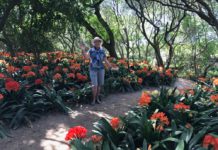We ended our South African adventure with a visit to Kruger National Park for a two day game drive.
The first day, we saw a total of 29 creatures – exotic birds such as blue-purple starlings, red and yellow hornbill, fish eagle, vultures, brown snake eagle and lilac-breasted roller and loads of animals, including elephants, zebras, warthogs, giraffes, waterbuck, steenbok, wildebeest and countless impala, kudu, three lions and a few white rhinos.

There were 24 of us from the original tour who extended the vacation with the safari. We travelled in groups of eight per vehicle with a driver-spotter guiding us for perfect viewing of wild life.

The etiquette in the park is that you are allowed to join others who have spotted something interesting but you cannot occupy the space for a long time: you need to have a good look and take photos and then move on to create space for others who want to see the creatures.

Of course, when we found two lions sleeping – a male and female – side by side in the open, it was a very popular spot.

The male lion – a classy full maned Lion King lion – woke up, casually made love to the female and quickly went back to sleep.
Apparently, this is fairly typical behaviour for the king of the jungle.

Giraffes have always been my favourite with their gorgeous faces, long eye-lashes and elegant, model-like legs and graceful, loping walk.

When a giraffe looks at you and blinks its exquisite eyes, it is almost like a wink from a beautiful girl. Well, at least it made me blush.

A lot of the animals wait for the perfect opportunity to cross from one side of the road to the other. They look at you for a long time to assess the danger and then, once they are convinced you mean them no harm, they cross over, again in a very graceful, relaxed way.

It is such a peaceful, gentle sight to see and we all never tired of the privilege of seeing these magnificent creatures in their natural habitat.
On our second day on safari, we immediately saw lots of giraffes and large herds of elephants.
A highlight was finding a lion, resting and completely exhausted after just killing a Cape buffalo.

Not far away, we also saw an impala dangling from a tall marula tree, dragged there by a leopard and left, out of reach of other predators, until the leopard could safely return at night to feed on its prize.
By the end of the day, we had seen dozens more elephants, nyala, plus some juvenile hyenas and large groups of enormous male cape buffalo as well as the ubiquitous impala and and kudu.

At a sizeable watering hole, we saw many hippos and some crocodiles that were so cleverly disguised as they lay on the banks that you would easily mistake them for driftwood or a jumble of rocks.
Our guides were happy that we were visitors who also enjoyed seeing birds and insects as well as trees and shrubs.

Sadly, some tourists arrive at Kruger insisting that they only want to see lions and show no interest in the dozens of other superb creatures.
Security is high in Kruger these days because poachers are still a serious problem, killing rhinos and elephants for their horns and tusks.

It is, of course, impossible to imagine why people would want to harm such superb creatures, but demand for these rhino horns and elephant tusks is still high in some parts of the world.























